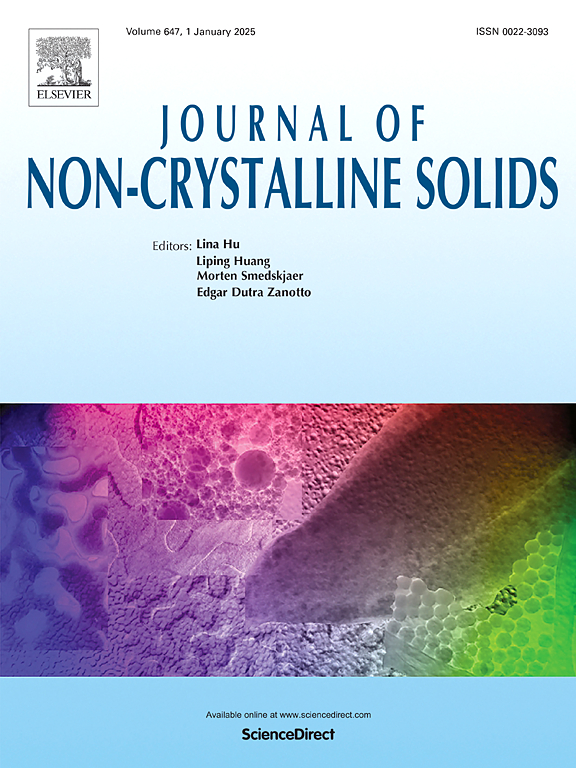Fabrication of colored R2O-MgO-Al2O3-SiO2 glass-ceramics with nano-sized crystals using natural basalt as a multifunctional additive
IF 3.5
3区 材料科学
Q1 MATERIALS SCIENCE, CERAMICS
引用次数: 0
Abstract
This study utilizes basalt enriched with transition metal elements (Fe, Cu, Ti) as a hybrid colorant and nucleating agent for R2O-MgO-Al2O3-SiO2 glass-ceramics. By employing TiO2 as a crystallization agent and regulating basalt doping levels (1–10 wt.%), dark-gray to black-gray glass-ceramics with smooth surfaces were prepared. Basalt content critically affects crystallization behavior, coloration mechanisms, and physicochemical properties. Differential scanning calorimetry and Fourier transform infrared spectroscopy analyses indicate basalt incorporation lowers the glass transition temperature, moderately weakens the glass network structure, reduces melt viscosity, and enhances ion migration. X-ray diffraction and scanning electron microscopy reveal that basalt content and heat-treatment temperature synergistically regulate microstructure: 1 wt.% doping refines crystallite size (average grain size: 25.52 nm), while 5 wt.% induces agglomeration (particle size d90 = 291 nm). X-ray photoelectron spectroscopy identifies coloration mechanisms driven by transition metal valence transitions, where Fe2+/Fe3+ redox pairs dominate chromaticity, while Cu+/Cu2+ equilibrium and stable Ti4+(d0) states enhance color uniformity. Heat-treatment temperature modulates metal ion valence evolution. Increased basalt content and temperature elevate bulk density (2.692–2.713 g/cm3). Microhardness slightly decreases (7.6–8.6 GPa) due to heterogeneous interfaces and grain coarsening, yet higher crystallization temperatures mitigate losses via increased crystalline phase content. All samples exhibit exceptional corrosion resistance (mass loss <0.08 %). The developed colored glass-ceramics integrate superior performance and aesthetic appeal, demonstrating promising applications in architectural curtain walls and corrosion-resistant coatings, while aligning with resource efficiency and environmental sustainability.
以天然玄武岩为多功能添加剂制备纳米级有色R2O-MgO-Al2O3-SiO2微晶玻璃
本研究利用富含过渡金属元素(Fe, Cu, Ti)的玄武岩作为R2O-MgO-Al2O3-SiO2微晶玻璃的杂化着色剂和成核剂。以TiO2为结晶剂,调节玄武岩掺杂量(1-10 wt.%),可制得表面光滑的深灰色至黑灰色微晶玻璃。玄武岩含量对结晶行为、显色机制和物理化学性质有重要影响。差示扫描量热法和傅里叶变换红外光谱分析表明,玄武岩掺入降低了玻璃化转变温度,适度削弱了玻璃网络结构,降低了熔体粘度,增强了离子迁移。x射线衍射和扫描电镜显示,玄武岩含量和热处理温度对微观结构有协同调节作用:1 wt.%的掺杂使晶粒细化(平均晶粒尺寸为25.52 nm),而5 wt.%的掺杂使晶粒团聚(粒径d90 = 291 nm)。x射线光电子能谱确定了由过渡金属价态转变驱动的显色机制,其中Fe2+/Fe3+氧化还原对主导色度,而Cu+/Cu2+平衡和稳定的Ti4+(d0)态增强了颜色均匀性。热处理温度调节金属离子价态演化。玄武岩含量的增加和温度的升高使堆积密度(2.692-2.713 g/cm3)升高。由于非均相界面和晶粒粗化,显微硬度略有下降(7.6-8.6 GPa),但较高的结晶温度通过增加晶相含量减轻了损失。所有样品都具有优异的耐腐蚀性(质量损失<; 0.08%)。开发的彩色玻璃陶瓷集卓越的性能和美学吸引力于一体,在建筑幕墙和耐腐蚀涂料中展示了有前途的应用,同时符合资源效率和环境可持续性。
本文章由计算机程序翻译,如有差异,请以英文原文为准。
求助全文
约1分钟内获得全文
求助全文
来源期刊

Journal of Non-crystalline Solids
工程技术-材料科学:硅酸盐
CiteScore
6.50
自引率
11.40%
发文量
576
审稿时长
35 days
期刊介绍:
The Journal of Non-Crystalline Solids publishes review articles, research papers, and Letters to the Editor on amorphous and glassy materials, including inorganic, organic, polymeric, hybrid and metallic systems. Papers on partially glassy materials, such as glass-ceramics and glass-matrix composites, and papers involving the liquid state are also included in so far as the properties of the liquid are relevant for the formation of the solid.
In all cases the papers must demonstrate both novelty and importance to the field, by way of significant advances in understanding or application of non-crystalline solids; in the case of Letters, a compelling case must also be made for expedited handling.
 求助内容:
求助内容: 应助结果提醒方式:
应助结果提醒方式:


